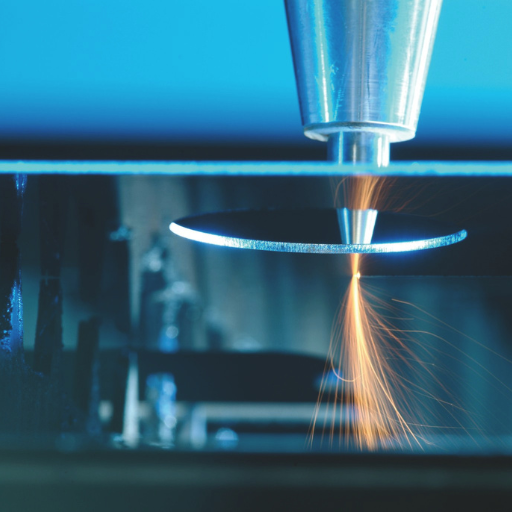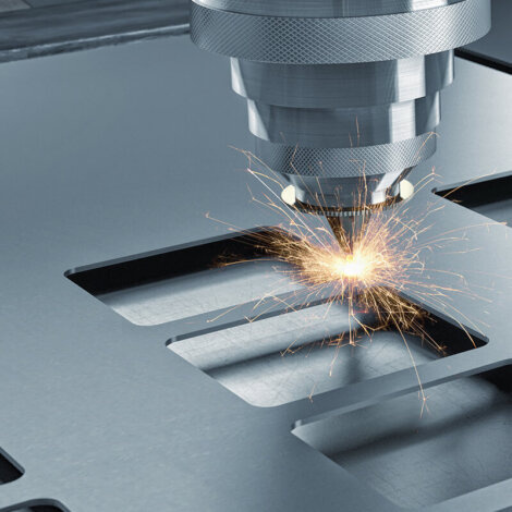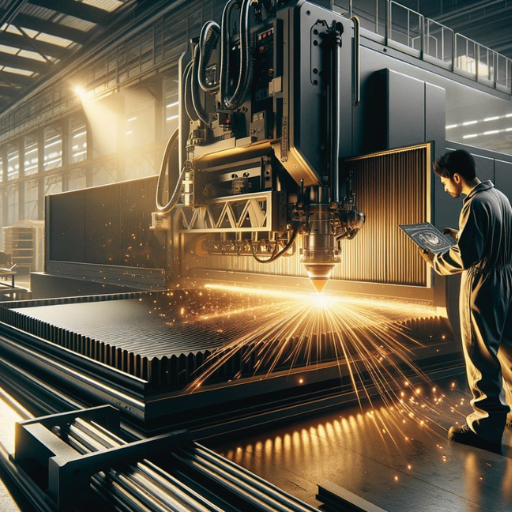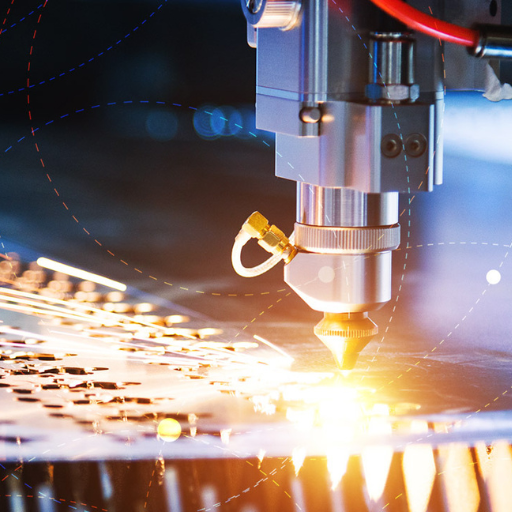In today’s rapidly evolving industrial landscape, precision and efficiency are paramount. Industrial laser cutting technology has emerged as a revolutionary solution, fundamentally transforming the way businesses operate. This remarkable technology harnesses the power of concentrated light beams to cut through a variety of materials with unparalleled accuracy and speed. From automotive manufacturing to electronics, laser cutting is an essential tool driving innovation and enhancing production processes across diverse sectors. In this blog, we’ll explore the key benefits of industrial laser cutting solutions, their applications, and how they are setting new standards for quality and performance in modern industry.
What is Laser Cutting and How Does it Work in the Industry?
Introduction to the Technology of Laser Cutting
Laser cutting is a technology that uses a concentrated light beam to cut or engrave materials accurately. In an industrial context, this involves passing powerful CO2/Fiber/Nd:YAG lasers through optics and CNC systems to follow specific predetermined patterns. The laser beam melts, burns, or vaporizes the material leaving behind a smooth surface finish. Common in industries such as automobile, aviation and electronics, it allows for extreme precision with minimal waste and ease of handling complicated designs. This technology enhances efficiency and accuracy of manufacturing processes while making it possible to produce components which meet the strict standards set by the industry.
Types of Lasers Used in Industrial Applications
In industrial laser cutting, three primary types of lasers are commonly used: CO2/Fiber/Nd:YAG lasers. Each type has its own unique features and benefits suited to different applications.
CO2 Lasers:
- Description: They use carbon dioxide gas as the active medium.
- Wavelength: Approximately 10.6 micrometers.
- Power Range: Typically between 20 watts and several kilowatts.
- Advantages: Ideal for wood, glass plastics etc unlike metals; also can do thick metal cutting.
- Applications: It is popular in automotive industry, aerospace industry signage among others.
Fiber Lasers:
- Description: These are optical fibers doped with rare-earth elements which include erbium or ytterbium.
- Wavelength: Usually around 1.06 micrometers.
- Power Range: From few watts to several kilowatts.
- Advantages: High electrical efficiency combined with low maintenance makes it ideal; Exceptional beam quality that cuts metals like steel, stainless steel and aluminum
- Applications: Preferred in electronics industry, metal fabrication sector as well as manufacturing medical devices.
Nd; YAG Lasers:
- Description : Employ a crystal of neodymium-doped yttrium aluminium garnet as the gain medium.
- Wavelength: 1.064 micrometers.
- Power Range: Varies from a few watts to hundreds of watts.
- Advantages: Can cut and weld; give accurate curved shape, thin walls etc
- Applications: Precision engineering, micro-machining and medical equipment producing are some examples.
For optimum performance, precision and efficiency in their manufacturing processes, the industry should therefore choose an appropriate laser type depending on the material in question as well as its intended use.
Process of Laser Cutting: From Beam Generation to Precision Cuts
Generation of laser beam is the first process in laser cutting. Typically, this involves a lasing medium placed inside a resonator. If energized by energy, it releases photons hence generating laser beam. This concentrated light then passes through mirrors or optical fibers that help focus it onto the surface being cut.
The high intensity of the laser is key to precision cutting because upon contact it melts, burns or vaporizes the material. A fine point focus creates melting that leads to power density hence allowing for precise cuts with intricate features that can be made by lasers. Computer numerical control (CNC) systems further manage cutting operations which are based on design specifications feed into them with almost absolute accuracy by superimposing signals upon one another so as to guide these activities.
A slit that is narrow is made by the laser beam, thus suitable for difficult designs. Laser gases like oxygen, nitrogen or air are used to blow away molten material and prevent it from oxidizing. This helps to improve the quality of the cut as well as achieve clean edges. Laser cutting is a very effective and versatile production process due to its combination of CNC control, assist gases and laser precision.
What Are the Main Applications of Industrial Laser Cutting Machines?
The Laser Cutting Dependence of the Automotive Industry
Laser cutting is widely used in the automotive industry due to its accuracy, effectiveness and versatility. Manufacturing laser cutting machines are key for making various components necessary for cars such as body parts, intricate engine components and electronic circuits. The need for complex shapes and detailed designs during modern automobile production makes precision laser cutting very beneficial. Besides, the industry has come to appreciate the speed of laser cutting in terms of reducing production times and cost. Furthermore, the use of a variety of materials such metals and composites demonstrates that laser cutting is very important in this sector. In addition, laser also reduces processing needs by producing high quality edges/finishes which leads to optimization of production.
Aerospace Engineering: Accuracy And Efficiency using Laser Systems
In aerospace engineering, laser technology plays a major role in manufacturing and assembling aircrafts including spacecrafts. This is because lasers are essential when it comes to slicing through materials accurately which is paramount in aerospace engineering. The ability of this technology to deliver intricate designs and complicated shapes without compromising their structural integrity ensures proper performance and safety aspects of air-borne vehicles. Moreover, high productivity levels caused by fast rates of implementing lasers reduce time needed in manufacture hence decreasing expenses incurred during building them up. Also, some high strength alloys as well as composites employed in aviation industries can be reduced into desired dimensions by these versatile machines called lasers. Besides that, laser systems cuts have less problems requiring further procedures so there is more flow towards actual manufacturing.
Electronics Manufacturing: High Accuracy Small Component Creation
In rapid changing world of electronics manufacturing industry; advanced precision for miniaturized delicate part production falls within domains where laser cutting technologies apply best1.In order to improve electronic devices’ efficiency longevity especially when they involve fragile pieces; highly accurate lasers are used.The current small but powerful consumer electronics require structural integrity without adding bulk therefore elements reduction is critical.Laser engraving aids producing sophisticated circuit boards as well as microprocessors necessary for highly sophisticated technological applications.The cutting also provides a clean burr free cut reducing the finishing requirements and enabling more efficient production cycles. Additionally, various materials such as silicon, polymers, and metals are easily worked on by the adaptability of laser systems used in modern electronics manufacturing.
Why Choose Laser Cutting Over Other Cutting Solutions?
Comparisons from the Conventional Cutting Techniques
Laser cutting as compared to traditional cutting methods has advantages that make it a first choice in many industries particularly. Mechanical cutting or water jet cutting are examples of traditional techniques which often have shortcomings in terms of precision, efficiency and versatility.
Precision:
- Laser Cutting: It can achieve high accuracy with tolerances up to ±0.001 inches, making it suitable for manufacturing electronics and medical devices where fine details are required.
- Traditional Cutting: The tolerances for mechanical and water-jet cutting usually are about ±0.01 to ±0.005 inches, which is not sufficient for most advanced applications.
Material Versatility:
- Laser Cutting: A wide variety of materials including metals, alloys, plastics, ceramics and composites can be cut this way. This is especially useful when working with hard-to-machine materials such as titanium and certain high-strength alloys.
- Traditional Cutting: Material compatibility may be limited. Mechanical cutting is not capable of handling harder materials properly while water jet cutting can only handle some composite and metallic materials satisfactorily.
Cut Quality:
- Laser Cutting: Burr free smooth edges that minimize secondary finishing processes. There’s very little heat-affected zone (HAZ) thereby preserving material integrity.
- Traditional Cutting: In most cases it results into rough edges which require additional deburring or finishing thus increasing production time and costs.
Speed and Efficiency:
- Laser Cutting: High-speed capabilities with rapid set-up times; operations can be continuous; therefore result in faster production cycles as it is highly automated.
- Traditional Cutting: Relatively slower due to the mechanical nature of the process and frequent tool changes/maintenance required.
Automation & Flexibility:
- Laser Cutting: Easily integrated into automated production lines as well as CNC systems thus enabling higher flexibility and repeatability by quickly switching between different types of cuttings without significant downtime lapses.
- Traditional Cutting: Less adaptable to automation; low overall efficiency because of tool wear and the need for manual intervention.
Summarily, laser cutting technology is superior to traditional cutting methods in precision, versatility of materials, quality of cuts and operational efficiency. These technological benefits are relevant to industries with high demands on accuracy and reliability.
Benefits in terms of Precision, Speed and Efficiency
Laser cutting technology has several advantages in terms of precision, speed, and efficiency:
Precision:
- Tolerance: The precision levels achieved by laser cutting can be as low as ±0.1 mm. This degree of accuracy is vital in applications where tight tolerances have to be maintained.
- Fine Detailing: While traditional methods may not easily achieve this; a focused laser beam can be used to create complex designs or intricate cuts on various materials.
- Minimal HAZ: Reduced heat-affected zone (HAZ) minimizes changes in material properties thereby ensuring that it retains structural integrity.
Speed:
- Cutting Rate: Depending on the material and thickness, laser cutters can achieve speeds between 20-70 inches per minute (IPM).
- Setup Time: Setup time is significantly reduced thus reducing overall production time; hence advanced systems increase throughput by minimizing downtime when moving from one job to another.
- Continuous Operation: High automation levels enable continuous operation which results into significant enhancements in production capacity up to 24/7 running cycles.
Efficiency:
- Material Utilization: Laser cutting provides precise cuts that minimize waste. For maximum material utilization or yield optimization nesting software is often applied during part layout.
- Energy Consumption: Laser advances have resulted in lesser energy consumption due to fiber lasers compared with older CO2 systems used previously.
- Reduced Secondary Processing: In many cases the clean cut edges produced through laser cutting eliminate other finishing requirements thereby lowering labor costs associated with these processes while saving time for lost labor.
In summary, laser cutting is distinguished by its peerless precision, which allows for extremely small details and tight tolerances; its high speed, which accelerates production cycles; and its overall efficiency, which maximizes material usage and minimizes energy consumption. These advantages make laser cuttings a preferred choice for industries that require high precision with increased output.
Cost-Effectiveness and Long-Term Savings
For industries, laser cutting offers significant cost-effectiveness and long-term savings. Initially, the upfront investment in a laser cutting system might be huge but it pays off in the long run through operational efficiencies. The accuracy of laser cuts reduces wastage of raw materials resulting to better utilization of expensive resources in terms of better direct costs on manufacturing raw materials. Additionally, automation as well as quick set-up times have reduced labor costs during production runs.
Moreover, this technology also helps reduce costs by enabling it to create complex designs without necessarily having additional tools or equipment needed for this purpose. In particular fiber lasers are known for their energy efficiency thus reducing operating expenses over traditional CO2 lasers. Consequently, low repair and replacement costs in the long term are among the other benefits due to modern machines’ capability of withstanding environmental impacts while remaining operational even under minimal maintenance and repairs requirements. Therefore, businesses benefit from lower running costs, less downtime and increased production capabilities thus reinforcing laser cutting as an essentially cost-effective manufacturing process.
How to Maintain and Service Industrial Laser Machines?
Regular Maintenance Practices for Optimized Performance
For peak performance and durability, regular maintenance of industrial laser machines is critical. Consider the following maintenance practices:
- Optics Cleaning and Inspection: On a regular basis, inspect the lenses and mirrors on your machine for dirt or grime that may be present. Use suitable non-abrasive cleaners to clean them so as not to obstruct the laser beam pathway.
- Laser Beam Checking and Alignment: Be sure that the laser beam is aligned properly. Poor alignment can lead to inaccurate cuts, among other things. Regular checks are necessary for alignment.
- Maintenance of the Cooling System: The cooling system prevents overheating. This means you must check the level of coolant regularly, clean filters in cooling units from time to time as well as ascertain that there are no impurities in the coolant.
- Luibrictioning: Friction and wear should be minimized by applying correct lubricants to moving parts. Follow manufacturer’s recommendation on lubrication interval and use appropriate oils.
- Consumables Inspection and Replacement: Nozzles, filters, protective windows etc., which are called consumables should be checked periodically to ensure their good operating state or replaced when it is necessary thus averting any stoppages in productivity.
- Software Updates with Calibrations: Ensure that you have installed recent software versions supplied by equipment producers besides recalibrating it after certain periods just to make sure that it does not fall out of defined bounds.
Routine maintenance listed above will result in reduced downtimes; longer life cycle of laser cutting machine; high-quality production standards will be maintained.
Troubleshooting Common Problems with Laser Systems
Poor Cutting Quality:
- Probable Causes: Dirty optics, wrong focal length setting, misalignment of a beam or too little power delivered;
- Solutions: Clean lenses and mirrors; refocus a laser; test-assemble lasers; identify material-related settings.
Non- Emitting Lasers:
- Possible Causes: Power supply malfunctions; defective laser tubes; software control issues.
- Solutions: Perform visual check-up on power supply connections, inspect the laser tube for damage, and verify thesoftware settings. Update or reinstall as necessary.
Overheating:
- Probable Causes: Underperformance of cooling system, blocked or dirty filters, lack of coolant in enough volumes.
- Solutions: Clean or replace filters for optimal operation of the cooling system and if required refill the coolant.
Inconsistent Cut Depth:
- Probable Causes: Different thicknesses of materials being cut, worn-out consumables such as nozzles and lenses, variable power input;
- Solutions: Maintain constant material thickness; replace consumables like nozzles and lenses when they become useless; ensure that there is a stable power source.
Software Errors & Calibration Problems:
- Probable Causes: Outdated software version or machine calibration errors
- Solutions: Keep updating machine software with latest versions from manufacturers besides making periodic recalibrations to maintain desired tolerances.
Swift response to these common problems ensures that your company achieves maximum performance as far as lasers are concerned and this will avoid any stoppages in production.
Repairing and Replacing Spare Parts
To keep laser systems running continuously and efficiently it is important to fix broken parts. Regular maintenance that involved timely replacement of worn out or damaged components has led to prevention of major crashes hence life extension of this equipment is achieved.
Identifying Faulty Parts: Inspections carried out on a regular basis can help detect potential problem areas. Laser tubes; lenses; mirrors; belts; cooling systems etc., are some examples hereof;
Sources for Quality Parts: Always buy from authorized dealerships when it comes to sources for spare parts since these came directly from manufacturers who know exact specifications which must be met by each part. For example, use non-genuine parts may affect the efficiency of your system thus making you lose all warranties provided with it.
Procedure for Changing Parts:
- Lasers and Tubes: Completely shut down the machine and follow the manufacture’s guide lines on how to safely remove and replace the laser tube.
- Lenses and Mirrors: Ensure that the lenses and mirrors are cleaned or replaced with caution so that light is transmitted optimally as well as reflected in the desired directions.
- Belts and Motors: Check for signs of wear in belts, if they exist, change them out; if they do not meet performance specifications, examine the motors.
- Cooling System Components: Filter replacements, coolant refills, and overall cleanliness must be done for all cooling system components to function effectively.
- Documentation and Calibration: Once any parts have been replaced it will be very important to recalibrate your equipment so that it does not lose its accuracy. Any changes made should be documented to maintain a detailed maintenance log for future reference purposes.
Regular maintenance plus proactively replacing parts can greatly improve the efficiency of laser systems hence their reliability by ensuring smooth operations leading to reduced downtimes.
What Innovative Uses of Laser Cutting are Emerging in the Market?
Additive Manufacturing: Advanced Laser Technology
During recent years, I’ve seen some exciting laser applications in additive manufacturing that are changing the industry. A few of them include:
Metal 3D Printing: Metal 3D printing using lasers has become a well-known and widely accepted industrial process especially Direct Metal Laser Sintering (DMLS) and Selective Laser Melting (SLM). These methods use high power lasers to melt metal powders together layer by layer as they form solid and complex metallic structures. The principal technical parameters range from 200 W to 1 kW of laser power, while the thickness is between 20 to 100 microns for accuracy and strength.
Complex Geometries: Lasers have enabled manufacture of complex designs that could not have been made before. Some examples are lightweight internal lattice-filled structures used in aerospace and medical implants. For these types of applications, important parameters include:
- Laser scanning speed: ranging from 300-700 mm/s
- Beam diameter: between50-80 microns
- Build volume: Dimensional variations but typically about 250 x 250 x 300 mm
Multi-Material Printing: Another new area is multi-materials printing where different materials can be printed during one session. Such capability offers gradient properties or integrated functionalities on objects among other things. Precise multi-laser coordination as well as favorable layer adhesion are examples of technical issues that need attention for efficient multi-material printing.
These milestones highlight how much impact laser technology may have in additive manufacturing; they bring improvement in design flexibility, material utilization or wastage minimization and production time saving.
Innovative Approaches to Laser Marking and Engraving
The versatility and efficiency of laser engraving and marking processes have improved significantly due to several technological advances. One significant breakthrough has been the advent of fiber lasers which provide unmatched precision combined with high speed making them suitable for intricate codes or detailed graphics on metals and plastics among other materials. Additionally, laser technology has seen increased integration of artificial intelligence (AI) and machine learning which have brought about adaptive marking processes that can automatically fine-tune a set of parameters based on the material being marked and desired outcomes. This makes it possible to achieve high-quality marks consistently with minimum human intervention. Moreover, development of multi–axis control systems has made engraving possible on curved or irregular surfaces thus increasing applications in this field. These developments demonstrate the growing capabilities and potential uses of laser engraving and marking techniques.
Emerging Trends for Industrial Laser Applications
Industrial laser applications in future, however, are characterized by significant focus on smart technologies i.e., AI and IoT for precision enhancement and process automation. It will facilitate real-time monitoring as well as adjustability leading to higher efficiency plus fewer mistakes. Secondly, there is an increased demand for green laser technology which is environmentally friendly as well as energy efficient; these lasers are expected to play a crucial role in sustainable manufacturing practices. Lastly, ultrafast laser technology advancement will transform industries through unprecedented speeds of precise micromachining and material processing. These trends seem to suggest a future where industrial capability advancement is accompanied by sustainability orientation and requirement for high level precision from lasers too.
Reference sources
- Source: The Fabricator – “How Laser Cutting is Driving Manufacturing’s Digital Transformation”
- Summary: This article from The Fabricator explores how laser cutting technology is at the forefront of manufacturing’s digital transformation. It discusses the increased precision, efficiency, and flexibility that laser cutting brings to modern manufacturing processes. The article also highlights real-world examples of how companies are leveraging laser cutting to innovate and streamline production.
- Source: ScienceDirect – “Laser Cutting Technology: A Review”
- Summary: This academic journal article provides an in-depth review of laser cutting technology, covering its principles, types, and applications in various industries. It examines the technological advancements that have made laser cutting a critical tool in modern manufacturing, emphasizing its impact on production speed, quality, and cost-effectiveness. The article is well-cited and offers a scientific perspective on how laser cutting solutions revolutionize industry practices.
- Source: Trotec Laser – “Advantages of Laser Cutting in Modern Manufacturing”
- Summary: This webpage from Trotec Laser outlines the advantages of using laser cutting in modern manufacturing. It details the benefits such as high precision, reduced material waste, and the ability to cut complex geometries with ease. The article also touches on various industrial applications, demonstrating the versatility and transformative power of laser cutting technologies in different sectors.
Frequently Asked Questions (FAQs)
Q: What are the benefits of modern industry from industrial laser cutting solutions?
A: Modern industries benefit from precision, speed and flexibility provided by industrial laser cutting solutions. These solutions employ high-power lasers that cut many kinds of materials with little waste and high efficiency to enhance productivity and lower costs.
Q: What types of materials can be processed using industrial laser systems?
A: Industrial laser systems are capable of processing a wide range of different materials, such as metals, plastics, ceramics or composites. Thin metal sheets can be processed up to thick steel plates; thus, it is versatile enough to handle diverse material properties and applications.
Q: How does laser marking contribute to industrial applications?
A: Laser marking is central in the industrial sector for traceability, quality control and branding. It ensures permanent marks on surfaces with good resolution, which make it good for labeling products, parts and components in various industries.
Q: What are the essential components of an industrial laser system?
A: An industrial lasers system has several essential components including the laser source, motion control systems, software and more. These work together to ensure precise delivery of consistent and uniform light for different processes involved in the material being worked upon by a laser.
Q: Why should you use turnkey laser systems?
A Turnkey Laser System offers various benefits that include easy integration into production lines reduced setup time and reliable performance. Such pre-configured optimized systems are ideal for quick deployment and efficient production because they have been designed for specific applications found in industries.
Q: How do companies show their customers how effective their industrial lasers work?
A: Companies often provide demos so that clients can learn more about what each company’s machine will do. Those who attend these demonstrations get firsthand information regarding its performance, accuracy levels as well as adaptability to suit customer distinctive preferences.













